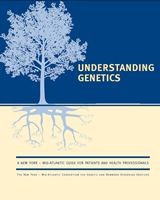All Genetic Alliance content, except where otherwise noted, is licensed under a Creative Commons Attribution License, which permits unrestricted use, distribution, and reproduction in any medium, provided the original work is properly cited.
NCBI Bookshelf. A service of the National Library of Medicine, National Institutes of Health.
Genetic Alliance; The New York-Mid-Atlantic Consortium for Genetic and Newborn Screening Services. Understanding Genetics: A New York, Mid-Atlantic Guide for Patients and Health Professionals. Washington (DC): Genetic Alliance; 2009 Jul 8.

Understanding Genetics: A New York, Mid-Atlantic Guide for Patients and Health Professionals.
Show detailsGenetic Testing
Genetic testing involves examining a person’s blood or other tissues to determine whether he or she has a change in his or her genetic material. Genetic testing may be useful in determining whether an individual has a genetic condition or may develop one in the future. The information gained from genetic testing may be helpful in a number of ways such as diagnosing a genetic disease, starting treatment, or initiating prevention strategies, as well as making life decisions such as career choice and family planning. Several types of genetic testing are available, and this appendix provides an overview of the genetic testing available, as well as who may be offered such testing.
Why Genetic Testing?
Genetic testing may be offered for a number of different reasons including:
- To confirm or rule out a diagnosis in an individual with symptoms of a genetic condition
- For individuals with a family history of or a previous child with a genetic condition
- To locate possible genetic conditions in newborn babies so treatment may be started immediately
How Is Genetic Testing Performed?
Genetic testing involves analyzing an individual’s blood, skin, hair, or other body tissue to look at his or her DNA, chromosomes, or proteins for a change, or mutation, that is associated with a genetic condition. When a mutation occurs, it may affect all or part of a gene and can result in an abnormal function leading to disease. Three major types of genetic testing are available in laboratories: cytogenetic (to examine whole chromosomes), biochemical (to measure protein produced by genes), and molecular (to look for small DNA mutations). (See Chapter 2 and Appendix I for more information.)
What Types of Genetic Testing Are There?
Newborn screening is the most widespread use of genetic testing. (See Chapter 4 for more information about newborn screening.) Almost every newborn in the U.S. is screened for several genetic diseases. Early detection of these diseases can lead to interventions to prevent the onset of symptoms or minimize disease severity.
Carrier testing can be used to help couples to learn if they carry—and thus risk passing to their children—an allele for a recessive condition such as cystic fibrosis, sickle cell anemia, and Tay-Sachs disease. This type of testing is typically offered to individuals who have a family history of a genetic disorder and to people in ethnic groups with an increased risk of specific genetic conditions. If both parents are tested, the test can provide information about a couple’s chance of having a child with a genetic condition.
Prenatal diagnostic testing is used to detect changes in a fetus’ genes or chromosomes. This type of testing is offered to couples with an increased chance of having a baby with a genetic or chromosomal disorder. A tissue sample for testing can be obtained through amniocentesis or chorionic villus sampling. (See Appendix E for more information.)
Genetic tests may be used to confirm a diagnosis in a symptomatic individual or to monitor prognosis of a disease or response to treatment.
Predictive or predispositional genetic testing can identify individuals at risk of getting a disease prior to the onset of symptoms. These tests are particularly useful if an individual has a family history of a specific disease and an intervention is available to prevent the onset of disease or minimize disease severity. Predictive testing can identify mutations that increase a person’s risk of developing disorders with a genetic basis such as certain types of cancer.
Forensic testing is used for identification, not to identify individuals at risk for a genetic disease. Forensic testing is performed for legal purposes such as criminal investigations, questions of paternity, and identification after catastrophic events such as Hurricane Katrina.
Who Should Consider Genetic Testing?
When deciding whether or not to get a genetic test for yourself or a family member, several issues need to be considered, both from a medical and an emotional standpoint. Genetic testing may provide a diagnosis and help provide information for symptom management, treatment, or lifestyle changes. However, genetic testing has limitations. When a genetic test detects a mutation, the test cannot always determine when or what symptoms of the condition may show, which symptoms will occur first, how severe the condition will be, or how the condition will progress over time. Even if a test is negative, an individual may still be at risk for a condition.
Due to the complexity of the medical and emotional issues involved in genetic testing, it is important to speak to a health professional such as a genetic counselor to help you understand the benefits and risks of genetic testing and to answer any questions you may have before and after testing. For information on genetic counseling, preparation for a genetic counseling visit, and sample questions to ask healthcare providers, see Appendix O.
References
- American College of Medical Genetics www.acmg.net.
- GeneTests www.genetests.org.
- National Society of Genetic Counselors www.nsgc.org.
- U.S. National Library of Medicine: Genetics Home Testing http://www.ghr.nlm.nih.gov/
- GENETIC TESTING - Understanding GeneticsGENETIC TESTING - Understanding Genetics
- extl3 exostosin like glycosyltransferase 3 [Xenopus tropicalis]extl3 exostosin like glycosyltransferase 3 [Xenopus tropicalis]Gene ID:493398Gene
- botv brother of tout-velu [Drosophila melanogaster]botv brother of tout-velu [Drosophila melanogaster]Gene ID:37198Gene
Your browsing activity is empty.
Activity recording is turned off.
See more...